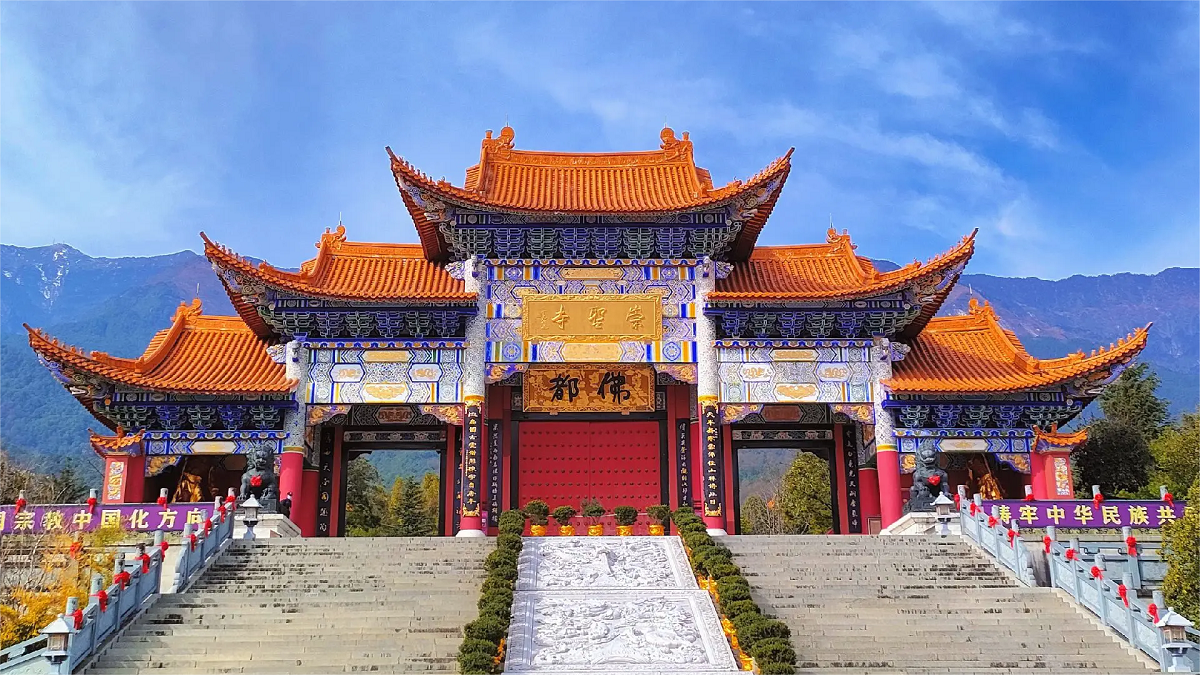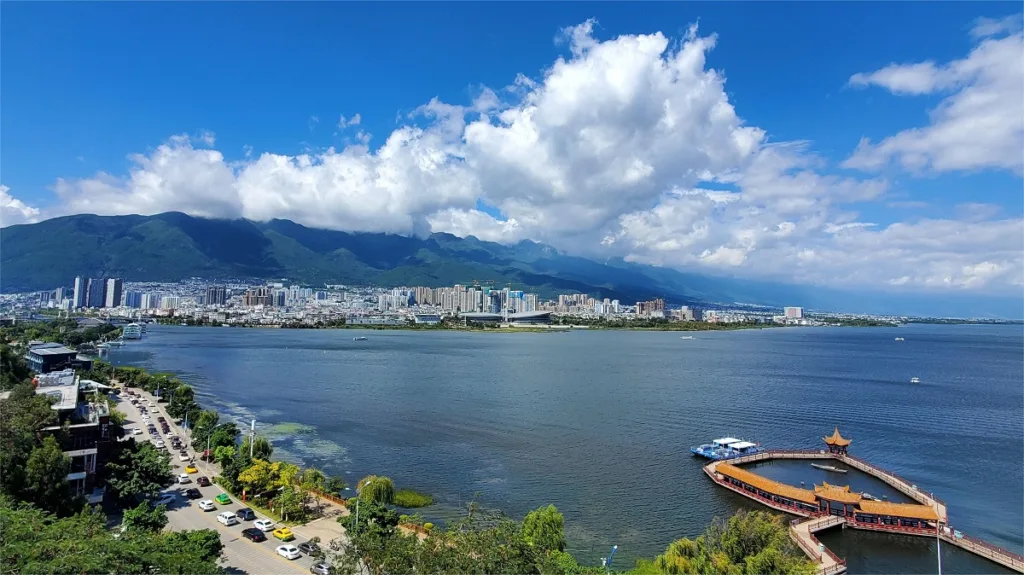Located in Dali, Chongsheng Temple (崇圣寺) sits to the east overlooking Erhai Lake and is backed by the Cangshan Mountains to the west. Historically, it held special significance as nine emperors from the Dali Kingdom renounced their worldly lives here, ingraining it deeply into local culture. In Jin Yong’s martial arts novel “Demi-Gods and Semi-Devils,” Chongsheng Temple is depicted as “Tianlong Temple,” adding to its mystique.
Chongsheng Temple was renowned for its five major treasures: three pagodas, a colossal bell cast in the Nanzhao period, a bronze statue of Guanyin, three golden statues of saints, and a plaque bearing the characters “佛都 (Buddha’s Land).” Unfortunately, throughout history, four of these treasures (apart from the three pagodas), along with the temple itself, were destroyed by warfare and natural disasters.
In the 1990s, plans were made to reconstruct Chongsheng Temple. The reconstruction project, with a total investment of 182 million yuan, was completed on April 22, 2005. Sculptures of the temple’s Buddhas were based on paintings from Song Dynasty, reflecting the multi-cultural influences of Dali and the compatibility of Buddhism, Chan Buddhism, and Tibetan Buddhism. In total, there are 598 Buddha statues and instruments made of bronze, with 574 statues gilded and painted, showcasing exceptional artistic value.
Table of Contents
- Basic Information
- Location and Transportation
- Map of Chongsheng Temple
- Highlights of Chongsheng Temple
- Vlog about Chongsheng Temple
- Attractions near Chongsheng Temple
Basic Information
| Estimated Length of Tour | 2 hours |
| Ticket Price | Admission: 75 RMB Admission + Round-Trip Shuttle Bus: 110 RMB |
| Opening Hours | 7.30 – 18.30; Last admission: 17.30 |
| Telephone Number | 0086-0872-2666158 |
Location and Transportation
Chongsheng Temple is located approximately one kilometer north of the ancient city of Dali in Yunnan Province, China. Situated east of Erhai Lake and west of Cangshan Mountain, it enjoys a picturesque setting amidst natural landscapes. Visitors can reach the temple by taking bus route 19 from the north gate of Dali Ancient City and disembarking at the “Three Pagodas Park” stop (三塔公园站).
Map of Chongsheng Temple

Highlights of Chongsheng Temple
Three Pagodas of Chongsheng Temple

Chongsheng Temple’s Three Pagodas consist of one large and two small pagodas. The main pagoda is known as the Qianxun Pagoda. Positioned 70 meters apart from the two smaller pagodas, they form a triangular layout. The existing height of the Qianxun Pagoda is 69.13 meters, with a base width of 9.9 meters. It is a square-shaped, multi-eaved, hollow brick pagoda with a total of 16 levels, making it one of the tallest surviving pagodas in China. As a typical architecture of the Tang Dynasty, it shares similarities with the Giant Wild Goose Pagoda and the Small Wild Goose Pagoda in Xi’an. The interior of the pagoda is vertically penetrated from top to bottom, with wooden stairs installed for access. These three ancient pagodas are landmarks of Dali, bearing witness to the prevalence of Buddhism in the region and adding to the scenic beauty of Cangshan Mountain and Erhai Lake.
Dapeng Golden-winged Bird Square
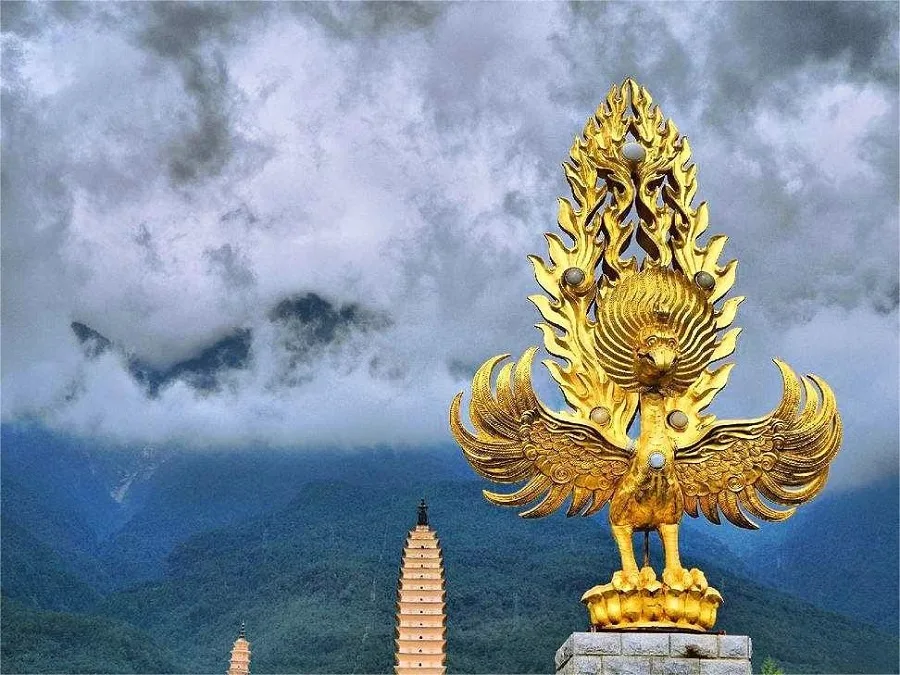
At the forefront of Chongsheng Temple’s entrance lies the Dapeng Golden-winged Bird Square, featuring a 6.9-meter-tall bronze statue of the mythical Dapeng Golden-winged Bird. This statue is modeled after the Golden-winged Bird artifact unearthed from the Three Pagodas site. The original artifact measures 18.5 centimeters in height and weighing 125 gram. The Dapeng Golden-winged Bird is depicted perched atop a blooming lotus, with its head held high and adorned with a crown of feathers. The head and tail feathers are curled upwards resembling flames, with five crystal beads embedded. The entire statue is made of bronze with gold leaf embellishments. This majestic statue adds a sense of grandeur and cultural significance to the temple complex, attracting visitors with its artistic beauty and historical symbolism.
The Nanzhao Jianji Grand Bell
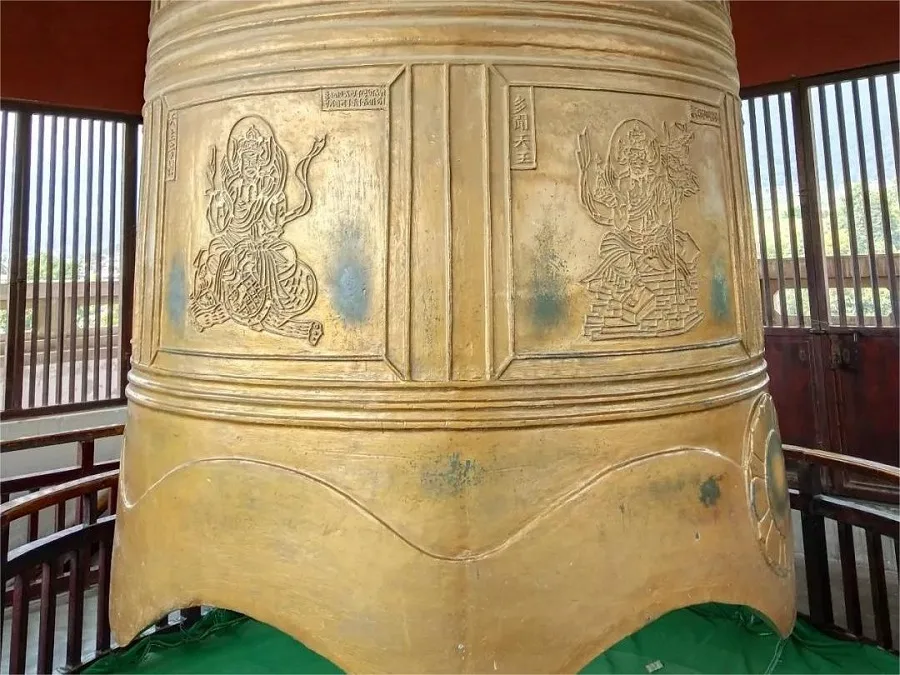
Cast in 871 AD during the reign of the Nanzhao Kingdom, this bell was described by the famous traveler Xu Xiake in his “Travel Diary of Yunnan” as “extremely large, with a diameter of over ten feet and a thickness of one foot. Its sound can be heard for eighty li (approximately 40 kilometers)…” It was one of the five great treasures of Chongsheng Temple and stood alongside the Three Pagodas as a symbol of the temple’s spiritual significance. Unfortunately, it was destroyed during the warfare of the Qing Dynasty’s Xianfeng and Tongzhi eras (1856–1872). In 1997, the bell tower and the bell were rebuilt. The reconstructed bell, measuring 3.86 meters in height, 2.138 meters in diameter, and weighing 16.295 tons, is the fourth largest bell cast in modern China and the largest bell in Yunnan Province.
The Rain Bronze Guanyin Hall
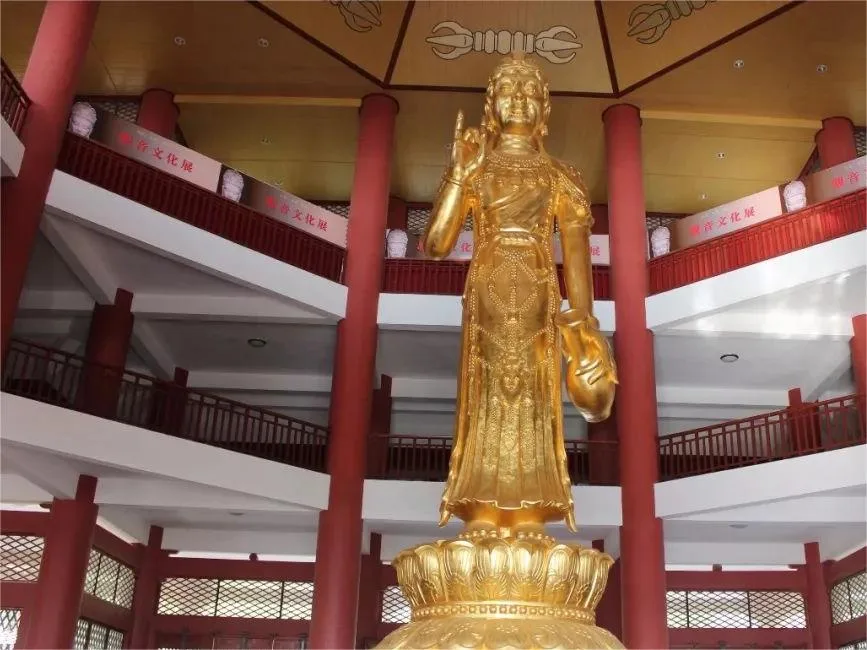
The Rain Bronze Guanyin Statue was cast in 899 AD during the reign of Emperor Zhaozong of the Tang Dynasty. Standing at nine meters tall, this gold-plated Guanyin statue depicts the bodhisattva holding a vessel of nectar in her lowered left hand and raising her right hand, symbolizing compassion and mercy. During the Cultural Revolution, the statue was destroyed as part of the “Destroy the Four Olds” campaign. In 1999, the Rain Bronze Guanyin Hall was reconstructed on its original site, towering at 29.99 meters high and covering an area of 8100 square meters. At the center of the hall, a 1.8-meter gold-plated bronze lotus pedestal supports an 8.6-meter-tall bronze Guanyin statue, weighing 11 tons. The reconstructed Guanyin statue, based on surviving photographs from the late Qing Dynasty, depicts a transition from male to female representations of Guanyin in the later periods of the Southern Yunnan and Dali regions.
Mahavira Hall

The Mahavira Hall is the highest-ranking building in the temple complex. Modeled after the Hall of Supreme Harmony in the Forbidden City in Beijing, this hall features a Qing Dynasty-style triple-eaved, nine-bay design with a three-tiered terrace. Spanning 51.7 meters wide and towering 26 meters high, it serves as the focal point of the temple.
Within the Mahavira Hall, visitors can marvel at the exquisite wood carvings of the “Zhang Shengwen Scroll,” a monumental artwork measuring 1.8 meters high and 117 meters long, adorning the walls. Additionally, the hall houses a colossal 2.03-meter-high and 119-meter-long niche containing the “Life Story of the Buddha,” depicted in 18 panels intricately carved into the doors of the hall.

